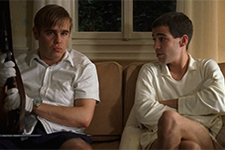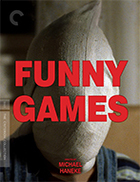Funny Games (1997)
|  A note on this (meta) review: I saw Michael Haneke’s English-language remake of his disturbing masterpiece Funny Games in theaters in the early spring of 2008. Before writing my review, I immediately went out and watched the original 1997 German-language version. Given that the films are virtually (and very purposefully) identical in every way and have same themes and intent, this review will read as a kind of “remake” of my review of the English-language version, maintaining large chunks of analysis that apply to both versions of the film. Michael Haneke’s Funny Games is a viciously effective polemic against the placid acceptance of film violence, a perverse experiment in audience manipulation that lures us into watching what should be unwatchable and then draws our attention to our unexamined desires. Given that movies are more violent than ever—whether they be high-octane action movies or grotesque horror films—Funny Games seems even more appropriate now than when it was made as a response to hyper-violent arthouse fare like Reservoir Dogs (1992) (although Haneke had originally come up with the basic idea for the plot in the late 1960s, the idea of using the thriller genre self-consciously against itself didn’t come until much later). The story is deceptively simple. It open with a comfortably wealthy family comprised of father Georg (Ulrich Mühe), mother Ana (Susanne Lothar), and adorable preteen son Schorschi (Stefan Clapczynski) driving out to their summer lakeside home in their Range Rover, towing a sailboat and playing guessing games with the opera on the CD player. Haneke immediately establishes that something will go terribly wrong when he breaks the reverie of Handle, Mascagni, and Mozart with the jolting screams of Naked City’s industrial heavy metal song “Bonehead,” an audacious and unsettling interruption that sonically foreshadows the intrusion of violence into the family’s otherwise serene existence and constitutes the first of many assaults on the audience’s sensibilities. Violence comes to the door dressed in gleaming white polos, white gloves, and deck shoes. Two young men, Paul (Arno Frisch) and Peter (Frank Giering), whom Georg and Ana had seen standing in the yard with their neighbors a few minutes earlier, appear at their door asking to borrow some eggs. There is something not quite right—oddly disaffected—about them, but they are well-dressed, well-scrubbed, and have the proper level of politeness and gentility. What follows is perhaps the film’s best sequence, as Ana goes through a verbal dance with Peter in which polite geniality is tested, then tested again, then tested yet again until it starts to crack and become terse frustration. The escalation is slow and methodical, and it’s impossible to tell at exactly what point we realize that there is danger in the air, although all pretenses are dropped with an exchange of insults, a slap, and then a golf club smashing Georg’s knee. At that point, it’s clear that the family is in for hell. What transpires over the next hour and a half is a sadistic game of cat and mouse in which the smiling, polite youth keep the family hostage in their own home, torturing them psychologically with a series of “games” in which their lives hang in the balance. The seclusion of the family’s summer home—well off the road and safely ensconced behind an electronic gate—becomes their prison, ensuring that no one can hear them scream and no one is coming to their aid (a phone “accidentally” knocked into the sink cuts off all outside contact). In other words, with little effort the intruders are able to turn the family’s security—the exclusive province of the wealthy—into a tool of their punishment. It should also be noted that all of the instruments of violence are not brought into the house by the intruders, but are already there: a golf driver, kitchen knives, and later a shotgun taken from the neighbor’s house. When the film premiered to a howling chorus of both cheering applause and raucous boos at the Cannes Film Festival, Haneke made it abundantly clear what his intentions were. In his director’s statement, he noted that film violence has been “domesticated” to the point of no longer rightly offending the audience, thus the question becomes not “how do I show violence, but how do I show the viewer his own position in relation to violence and its portrayal?” To this end, Haneke steps outside the bounds of the conventional thriller and adopts several Brechtian techniques that directly confront the viewer with his or her culpability in watching the film. Several times Paul breaks the fourth wall, addressing the audience directly either with his knowing gaze or by speaking to us, taunting us with what he knows are our generic desires. Do we want to see more? Do we want to see a proper ending? What would a proper ending in such a film look like? We get a glimpse when Haneke allows the film to diverge into more traditionally gratifying territory, only to cruelly rewind it and set it back on its original, nihilistic trajectory. It is this teasing attitude, this viciousness disguised as playfulness, that set off so many viewers. Haneke’s experiment is a success if you walk out of the film not only talking about it, but questioning your own role as an accessory to the film’s “crime.” Art film enthusiasts will likely do this if only because they know they’re supposed to, which feeds into criticisms that the film is just a sop to the egos of “sophisticated” filmgoers who can revel in their own intelligence and bemoan the density of the general movie-going masses who won’t “get it.” Of course, Haneke purposefully tried to make the film as accessible as possible to the mass audience (which is also why he made an English-language shot-for-shot remake in 2007), which is crucial to its point, especially for the gory horror movie crowd for whom human suffering is a typical night out on the town. Yet, the true brilliance in the film is this: Regardless of the viewer’s response, Haneke wins. If they “get it,” then his film has successfully drawn the viewer’s attention to the otherwise unexamined. If the viewer doesn’t “get it,” then the film has proved the point that we are, in fact, inured to onscreen bloodshed. Either way, Haneke’s film is vividly conceived and dazzling in its manipulation of audience expectations, simultaneously gratifying and thwarting them in the way that only a truly masterful filmmaker is capable.
Copyright © 2019 James Kendrick Thoughts? E-mail James Kendrick All images copyright © The Criterion Collection | |||||||||||||||||||||||||||||||
Overall Rating: 


 (4)
(4)


